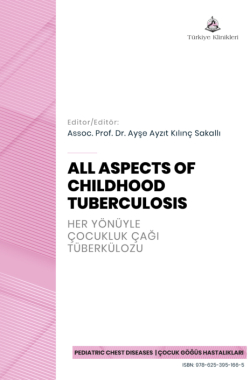Contact Evaluation
Ebru KÖSTERELİa , Zeynep Seda UYANa
aKoç University Faculty of Medicine, Department of Pediatric Chest Diseases, İstanbul, Türkiye
Köstereli E, Uyan ZS. Contact evaluation. In: Kılınç Sakallı AA, ed. All Aspects of Childhood Tuberculosis. 1st ed. Ankara: Türkiye Klinikleri; 2023. p.103-6.
ABSTRACT
Since children usually get the tuberculosis (TB) bacillus from adult TB cases, TB problem in childhood is one of the most important indicators of the effectiveness of adult TB control programs. When an adult is diagnosed with TB, when contact screening is performed, children younger than 5 years of age should be carefully evaluated, because in this age group, there is a higher risk of developing post-infectious disease, and severe forms of the disease such as miliary TB and TB meningitis. Therefore; contact screening and treatment in adult TB patients are very important in preventing TBrelated morbidity and mortality in children. The contact is usually within the household members, but may also occur in the school, nursery, nursing home or other confined places. At the contact stage, tuberculin skin test (TST) is negative, chest X-ray is normal, and the child has no signs and symptoms of the disease. With the contact examination, those who are sick and those who are infected are detected. Contact examination in pediatric patients generally aims to find the source case.
Keywords: Child; tuberculosis; contact; evaluation
Kaynak Göster
Referanslar
- Guidance for national tuberculosis programmes on the management of tuberculosis in children. Second edition. 2014. [Link]
- Graham SM, Ahmed T, Amanullah F, et al. Evaluation of tuberculosis diagnostics in children: 1. Proposed clinical case definitions for classification of intrathoracic tuberculosis disease. Consensus from an expert panel. J Infect Dis 2012;205:Suppl. 2:S199-S208. [Crossref] [PubMed] [PMC]
- T.C. Sağlık Bakanlığı. Tüberküloz Tanı veTedavi Rehberi. Ankara: 2019. p.11.
- Kut A. Ailede tüberküloz hikayesi ve ateşi olan yedi aylık kız hasta. Vakalarla Çocuk Göğüs Hastalıkları. 2014;376.
- Schaaf HS, Michaelis IA, Richardson M, et al. Adult-to-child transmission of tuberculosis : household or community contact. Int J Tuberc Lung Dis. 2003;7: 426-31.
- Schluger NW, Rom WN. The host immune response to tuberculosis. Am J Respir Crit Care Med. 1998;157:679-91. [Crossref] [PubMed]
- Marais BJ, Gie RP, Schaaf HS, et al. The natural history of childhood intra-thoracic tuberculosis: a critical review of literature from the pre-chemotherapy era. Int J Tuberc Lung Dis. 2004;8:392-402.
- Ferebee SH. Controlled chemoprophylaxis trials in tuberculosis: a general review. Adv Tuberc Res. 1970;17:28-106.
- Gryzbowski S, Barnett GD, Styblo K. Contacts of cases of active pulmonary tuberculosis. Bull IUAT. 1975;50:90-106.
- Capewell S, Leitch AG. The value of contact procedures for tuberculosis in Edinburgh. Br J Dis Chest. 1984; 78:317-28. [Crossref] [PubMed]
- National Tuberculosis Controllers Association; Centers for Disease Control and Prevention (CDC). Guidelines for the investigation of contacts of persons with infectious tuberculosis. Recommendations from the National Tuberculosis Controllers Association and CDC. MMWR Recomm Rep. 2005;54(RR-15):1-47.
- T.C. Sağlık Bakanlığı. Tüberküloz Tanı veTedavi Rehberi. Ankara: 2019. p.177-8.
- T.C. Sağlık Bakanlığı. Tüberküloz Tanı veTedavi Rehberi. Ankara: 2019. p.180-1.
- WHO. Consolidated guidelines on tuberculosis Module 5: Management of tuberculosis in children and adolescents. 2022:15.
- T.C. Sağlık Bakanlığı. Tüberküloz Tanı veTedavi Rehberi. Ankara: 2019. p.141.
- Kilicaslan Z, Kiyan E, Kucuk C, et al. Risk of active tuberculosis in adult household contacts of smear-positive pulmonary tuberculosis cases. Int J Tuberc Lung Dis. 2009;13:93-8.
- Lisa V Adams. Tuberculosis infection (latent tuberculosis) in children. This topic last updated: Aug 10, 2023. [Link]

